Study Notes
Checklists
Karsh/Wilding/Cameo:
![]() Karsh
Karsh
![]() Wilding
Wilding
![]() Cameo
Cameo
Centennial:
![]() Centennial
Centennial
Caricature & Landscape:
![]() Caricature
Caricature
![]() Landscape
Landscape
![]() Cityscapes
Cityscapes
Environment:
![]() Flowers
Flowers
![]() Trees
Trees
![]() Street Scenes
Street Scenes
![]() National Parks
National Parks
![]() QE II
QE II
![]() Parliament
Parliament
![]() Maple Leaf
Maple Leaf
Artifact & Parliament:
![]() Low-value
Low-value
![]() Medium-value
Medium-value
![]() Parliament (bklt/coil)
Parliament (bklt/coil)
![]() Parliament (1st class)
Parliament (1st class)
Mammals & Architecture:
![]() Low-value
Low-value
![]() Medium-value
Medium-value
![]() Architecture
Architecture
![]() QE II
QE II
Berries,
Fruit & Flag:
![]() Low-value
Low-value
![]() Medium-value
Medium-value
![]() Flag (first class)
Flag (first class)
![]() Flag (vending bklt)
Flag (vending bklt)
![]() Flag (self-adhesive)
Flag (self-adhesive)
![]() Flag (coil)
Flag (coil)
Trade, Leaf & Wildlife:
![]() Low-value Trades
Low-value Trades
![]() Medium-value Trades
Medium-value Trades
![]() 1st class/Medium-value Maple Leaf
1st class/Medium-value Maple Leaf
![]() 1st class Leaf Coil
1st class Leaf Coil
![]() Medium-value Wildlife
Medium-value Wildlife
![]() High-value Wildlife
High-value Wildlife
Insect, Flag, Leaf & Flower:
![]() Insects 2007-
Insects 2007-
![]() Flag (vert) 2004-
Flag (vert) 2004-
![]() Maple Leaf 2003-2004
Maple Leaf 2003-2004
![]() Flowers
Flowers
Other
Updated Jun 14/05
Low-value Trades
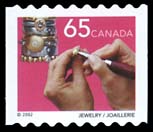
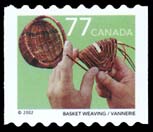
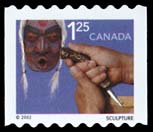
|
Canada Post seems to be having "trouble" deciding what type of medium-value definitives to issue.
After the Fruit Trees (1991-1998) came only a set of 3 Stylized Maple Leafs (1999-2000) and a set of 3 Wildlife (2001). Now we have a set of 3 medium-value Traditional Trades which lasted for only one rate period (the 48c era).
| Value | Coil (roll of 50) |
Booklet (pane of 6) |
| 65c Jewelry | Jan 2/02 | Jan 2/02 |
| 77c Basket Weaving | Jan 2/02 | |
| $1.25 Sculpture | Jan 2/02 | Jan 2/02 |
The date shown is the date of issue of that specific variety. A "blank" means the item does not exist.
The 65c and $1.25 values were issued in both coil and booklet formats. These can be differentiated apart by looking at the serpentine die cutting.
Peaks and valleys
The serpentine die cutting on these stamps have peaks and valleys: a stamp is identified as either "peak at upper left" or "valley at upper left" based on the very first die cut:
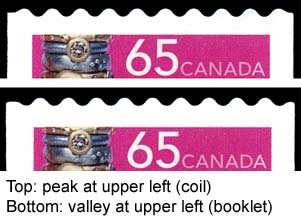
The three Trades coils have a "peak at upper left" while the two booklet stamps have a "valley at upper left".
Coloured "perfs"
The two Trades booklet stamps come, by design, three different ways based on the appearance of ink colour on the tips of the serpentine die cuts. This is due to the position of the stamp within the booklet pane.
Stamps from the first row of the pane have coloured "perfs" at both the top and bottom; stamps from the second row have coloured "perfs" at the top only; stamps from the third (bottom) row of the pane have coloured "perfs" only at the bottom of the stamp.
The amount of colour on the tips of the die cuts may vary depending on any minor shift in the die cutting. It is possible to find a booklet stamp without any colour on the tips of the die cutting due to a significant shift in the die cutting.
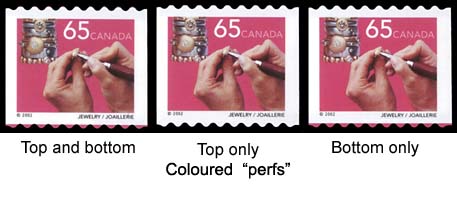
Gutters
All three coil stamps were printed in rolls of 50 with a 10mm gutter between every 25 stamps. These should be collected in strips of 4 with the gutter centered.
Coil re-prints
The original printings of the three coils, on Jan 2, 2002 had a 10mm rouletted backing paper tab at the start of the roll. A reprint (Feb 2002 for the 65c and Mar 2002 for the 77c and $1.25 stamps) came with a 5mm wavy die-cut on the starter tab. This reprint also introduced a 5mm wavy die-cut end tab.
In May 2003, the 65c appeared with 5mm straight die-cut tabs at the start and end.
All start and end strips should be collected in strips of 4.
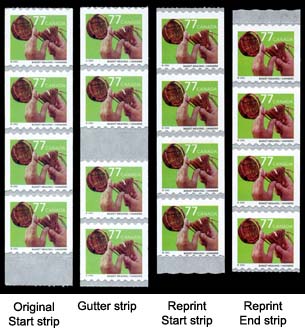
Coil display cards
The three coils were shipped with display cards allowing the coil to hang from a peg on the post office wall.
The original display card had the Canada Post logo in black & white. The Feb/Mar 2002 reprints introduced a new display card where the Canada Post logo is in colour.
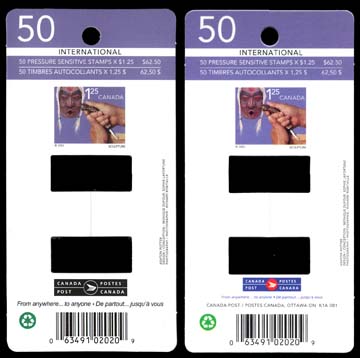
Booklet covers
A reprint of the booklets in May 2002 resulted in a subtle change on the booklet cover. The Canada post logo was changed from black & white to colour.
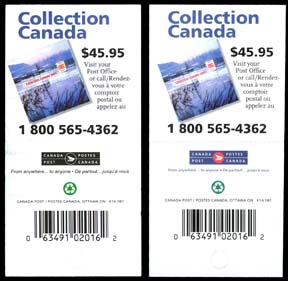
© 1999-2013, 2014 Robin Harris
Adminware is a trademark of Adminware Corporation.
